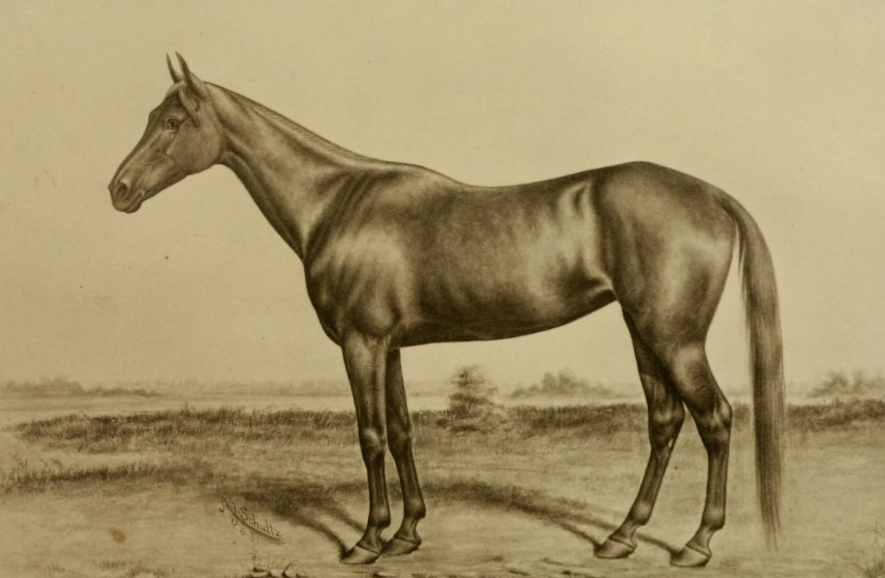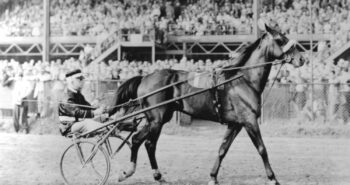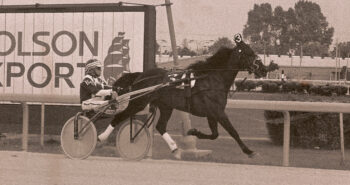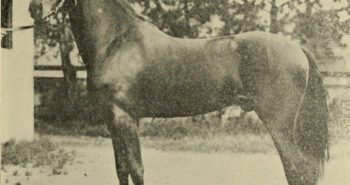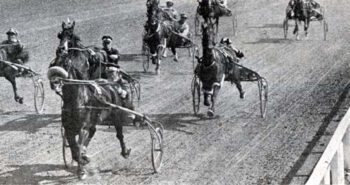The first of the champions to have an unblemished career, Maud S was one of the best trotters in the high wheel sulky era and lowered the world record a whopping six times.
One of the many great trotters of the 1800s born at the famed Woodburn farm, the 1874 mare Maud S was one of several sold to Captain James Bugher (of the famous Cincinnati & Memphis Steamboat Line) and WP Hulburt of Cincinnati at an a farm auction in 1875. From the Cincinnati Enquirer, “They succeeded in buying several, among them Maud S (then without a name) and another filly, which looked so much like her that after they arrived home neither gentleman could tell which one he individually had bought; both wanted the same filly, and that one was not Maud S. They thought she was of the two the least desirable. After several discussions on the subject it was decided that Mr Hulbert could have his choice, which of not much value in comparison with Maud S.” Captain Bugher named his new filly Sadie Bugher.
Both Warren Peabody and Otis Dimmick, both skilled trainers with good reputations, tried their hands on the strong-willed filly without much success. The following year the then-3-year-old filly was sold to George Nelson Stone, president of the Charter Park Association by Bugher’s son Horace, who had taken over the mare after his father’s death in 1876. Stone renamed her Maud S after his 12-year-old daughter. The young filly was social and lovely to be around, but with a harness on her things changed. Stone moved the headstrong little miss to William W Bair, who had his stable at Chester Park racetrack in Cincinnati, and was the person to recommended to Stone that he buy the three-year-old filly. According to an article published after the mare’s death, “Bair had to rebreak her, and by infinite patience succeeded in getting into her good graces. That year, the three-year-old Maud S showed 1.13 (a kilometer rate of 1.30,7, mile rate of 2:26) over one lap on the half-mile track.”
Her debut came the following year at the county fair where she completely obliterated all opposition, winning by numerous lengths. Maud S was taken to the Lexington meeting in October 1878, and even though the four-year-old had not raced any real opposition her reputation preceded her. New York turfman Joseph Harker offered $20,000 for Maud S, providing she showed a mile in 2:20 (1.27,0). In a workout at Lexington on a very windy day on Oct 22, 1878, the four-year-old mare trotted 2:22 3/4 (1.28,7), the half-time 1:11 1/2. Four days later she did another two public workouts. After doing the first in 2:23 (1.28,9), in the second she and trotted in “the altogether unprecedented and unexpected time of 2:17 1/2 (1.25,5)”, quarter times 33 1/4, 1:06 and 1:41. The time was the fastest ever for a four-year-old but, since it wasn’t in a race or official trial, Governor Sprague’s 2:21 1/4 (1.27,8) from 1875 survived for a little bit longer. Harker would later explain that “I bought Maud S from George Stone of Cincinnati for $20,000, but as Mr Vanderbilt took a fancy to her I let her go.” As Stone had promised trainer Bair $1,000 if Maud S would beat 2:18 (1.25,8), William Henry Vanderbilt bought the filly for $21,000, which the wealthy New Yorker readily coughed up.
After her purchase, Vanderbilt turned the mare over to Carl S Burr, the famous Long Island trainer. It was same old, same old, though, as the stubborn mare refused to get along with her trainer. In September 1879, Vanderbilt decided to send Maud S to the one trainer she got along with, William W Bair, and made her former owner George Stone her manager. The pair got along, and the following June the mare worked out in 2:23 1/2 (1.29,2) at Charter Park. On July 6, she then won the 2:34 trot at Chester Park in three straight heats against easy opposition, winning in 2:25, 2:30 and 2:28 (1.30,1, 1,33.2 and 1.32,0). Going to Chicago in July 1880, Maud S showed what was to come when she defeated the five-year-old mare Trinket in three straight heats in a match race. After winning the first two in 2:19 and 2:21 1/4 (1.26,4 and 1.27,8), she was turned loose in the third and came home in 2:13 1/2 (1.23,0). That was only 3/4 behind St Julien’s world record set in October the previous year, and the fastest heat by one second ever trotted in a race. The previous record being Goldsmith Maid’s 2:14 3/4 (1.23,7) at Rochester in Aug 1874.
The rivalry with St Julien
After defeating Driver, Charley Ford and Hannis in the 2:19 trot at Cleveland on Jul 28, 1880, she took on the same trio in the same class at Buffalo one week later. A break caused her to loose the first heat, won by Charley Ford in 2:17 (1.25,1), but then won the next three in 2:15 1/4, 2:16 3/4 and 2:16 1/2 (1.24,1, 1:25,0 and 1.24,8). That was the only heat Maud S lost, and this was her last ordinary race. On Aug 12, Maud S and St Julien met in a match race with separate time trials at Rochester. First St Julien and Orrin Hickok trotted in 2:13 3/4 (1.23,1). Maud S then came out. From the Chicago Tribune, Maud S “took the word so quickly that it was not thought that Bair was driving for a fast heat. Her easy, elastic gait was very deceptive, and it was not until she shot by the quarter pole in 32 1/2 that the crowd realized how fast she was going. Maintaining a steady pace along the backstretch, she reached the half in 1:05. On the next quarter, she fell off three-quarters of a second, and passed the pole in 1:38 1/4. Trotting the final quarter in 33 1/2, she returned to the stand amid a storm of applause in 2:11 3/4 (1.21,9). Bair stated that he did not intend to drive a fast heat when he started, but the mare was inclined to go along, and he let her trot on her disposition to the middle of the homestretch, and tapped her gently from there to the wire.”
In his second trial, St Julien “darted away at unrivalled speed, and whirled around the turn to the quarter in 31 3/4. Easing him along the backstretch, Hickok sent him ot he half in 1:04 3/4. His speed on the third quarter dropped to a 2:16-gait, and the watched marked 1:38 3/4, but as he entered the final quarter on his homestretch he increased his pace and trotted to the wire in 2:11 3/4 (1.21,9). Hickok was greatly disappointed at not having done better. His explanation was that his horse had been having easy races, and was not conditioned as he should have been for such a trial. He also regretted having sent him off in the first heat.” George Stone declined to speed Maud S in another fast mile, her jogging in 2:20 1/4 (1.27,2) instead. After St Julien then jogged a third mile in 2:24 1/2 (1.29,7), floral saddles were presented to both, the one given to St Julien labelled “To the King of the Turf”, while that to Maud S “To the Queen of the Turf.”
St Julien lowered the record to 2:11 1/4 (1.21,6) at Hartford on not long after, on Aug 27, 1880. Three days prior, Vanderbilt had sent a dispatch to George Stone instructing him not to run the mare any more that season, requesting that she be taken to Cincinnati and kept in condition for his personal driving. However, St Julien’s new record caused him to change his mind. After trialling in 2:11 1/2 (1.21,7) at Chicago on Sep 16, two days later she recaptured the crown when she trotted in 2:10 3/4 (1.21,3) under challenging conditions, quarter times 34, 1:04 3/4 and 1:36. The second quarter, at a 2:03 gait, was the fastest on record by then. The Chicago Daily Telegraph‘s article stated “the sorrel queen of the turf faces a heavy gale with flying feet.”
A pacer who created resentment
It all seemed easy for Maud S, but even though she appeared to be a natural trotter that wasn’t the case. In The Horse of America in his Derivation, History and Development, John H Wallace writes that “Maud S was a pacer and Sunol was a pacer, although neither of them ever paced in public, and the fact that they ever paced at all was held as kind of ‘home secret'”, going on to say that “she had to wear toe-weights through all her brilliant career to keep her on her gait as a trotter. Wallace was not known to shy away from controversy, despite the above statements causing some resentment.
It wasn’t the only resentment caused – though both instances were really about the egos of a few men. In an editorial ahead of the 1881 season, the Spirit of the Times said that “it will be well for leading trotting associations to bear in mind in their calculations for the sport of 1881 that the great card promises to be the probable contests between Maud S and St Julien. The mare is being carefully prepared for an active campaign, in which it is the desire of her owner, William H Vanderbilt, that she shall set the mark as low as possible, after which he will feel that he has done his duty toward the public and will take the liberty of enjoying his expensive purchase himself.” It should be added, though, that even though she was Vanderbilt’s pride and joy, her fame caused him to be jealous. When her owner drove her on the road people – he drove Maud S “almost any fine afternoon on Fifth Avenue – would often say “There goes Maud S” instead of “There goes Mr Vanderbilt”, something the wealthy man actually resented.
Breaking the 2:10 barrier
Maud S came back even better in 1881. First she lowered the track record at Columbus, wiping out Rarus’ 2:17 1/2 when she trotted in 2:13 1/4 (1.22,8), before she did the same at the Hamtramek track in Detroit, lowering St Julien’s 2:16 1/4 (1.24,7) track record to 2:13 3/4 (1.23,1). At Pittsburgh on Jul 13, over a track heavy from rain that morning, she then lowered her world record by a quarter to 2:10 1/2 (1.21,1), quarter times 33, 1:05 1/2 and 1:37 1/4. She put in another great performance in Detroit on Jul 23, 1881, trotting in 2:11 (1.21,4) on a track considered 1 1/2 to 2 seconds slow. Numerous newspapers reported that “the achievement is considered one of the best the mare has ever made.”
The world record was lowered again on Aug 11, 1881 when she trotted in 2:10 1/4 at Rochester. “At 3:35 the magnificent mare jogged past the grand stand. Every eye was on her, and there was great enthusiasm. Again the passed the stand, and trotting around the turn and nearing the judges’ stand, Bair nods and the nod is returned. She is off. What a magnificent animal she is. How she flies along. The running horse accompanying her can not keep pace with her. He is two lengths behind and doing his best. The first quarter is reached and the time is 32 3/4 is called out. ‘Will she beat her record’ is the whispered inquiry. ‘Never mind, only look at her.’ It is only an instant, and she reaches the half mile post, 1:05 1/4. She must increase her pace. She does it like a bird. She skims along and passes the three-quarter pole in 1:37 1/2. If she does not break she will beat 2:10 1/2. There is no sign of a break, and as at the start she places each foot just where it should go. Down the stretch she comes, and in splendid form passes under the wire in 2:10 3/4 (1.21,3). Three cheers go up, and the Vanderbilt party wave their hats, and in an instant the official time is hung out by the judges, and the applause of 20,000 people greet it.”
Though used as a road horse by Vanderbilt for 1882 and some of 1883, Maud S and Aldine lowered the double team record from 2:16 3/4 to 2:15 1/2 (from 1.25,0 to 1.24,2) on Jun 15, 1882. The flying chestnut mare almost lost her world record in 1883, though, with the brown gelding Jay-Eye-See trotted in 2:10 3/4 (1.21,3). As an aside, Jay-Eye-See and Maud S had relatively similar pedigrees: both had Hambletonian as a paternal grandsire, both were out of Pilot Jr mares, and while Jay-Eye-See’s damdamsire is Lexington, the damdamsire of Maud is Boston, none other than Lexington’s sire. The appearance of the four year younger gelding caused Vanderbilt to send Maud S to Bair early in 1884, and the eight-year-old mare had a lot left. Maud S did a public workout in 2:11 1/2 (1.21,7) in late July, but on Aug 1, 1884, Jay-Eye See trialled in 2:10 (1.20,8) at Narrangansett Park, a little outside of Providence. Maud S wasted no time in recovering her title as the fastest trotter in the world. The following day, at the Glenville track in Cleveland, Maud S became the first sub-2:10 trotter when she came home in 2:09 3/4 (1.20,6), quarter times 32 3/4, 1:04 1/4, 1:36 1/4. The track was estimated to be close to two seconds slower than the Providence track.
From one tycoon to another
Two weeks later, the world was surprised when fellow New Yorker Robert Bonner bought Maud S for $40,000. Former owner William Vanderbilt had in fact received an offer for $100,000 for Maud S, but sold her to Bonner who he knew wouldn’t trot her in public races. Shipping her south for the Lexington meeting in October. Plenty of rain caused her record attempts to be postponed, and the daughter of Harold had to wait until Nov 11, 1884. The legendary trainer Hiram Woodruff always said that “you can never have a fast mile after frost has struck ground”, but Maud S proved him dead wrong as she posted quarters of 32 3/4, 1:04 and 1:37 to come home in yet another new world record: 2:09 1/4.
Perhaps surprisingly, Maud S returned to Bair yet again at the end of Jun 1885 for yet another crack at returning the world record. At Cleveland on Jul 30, 1885, the chestnut mare put in quarters of 32 3/4, 31 3/4, 31 and 33 1/4 seconds to come home in 2:08 3/4 (1.20,0). It was a fantastic world record and surprisingly, the track was considered slow. That race in Cleveland was her final start. But could she have gone faster? Joseph Harker, who almost bought Maud S in 1878, certainly believed so: “I think there were days when Maud S could have stepped one mile to high wheels in 2:06. Why, after her racing days were over, WH Vanderbilt drove her himself to the pole with Aldine to a top buggy weighing 180 pounds in 2:15 1/2, and, mind you, Aldine could not trot single better than 2:20. Just think of Maud S dragging her mate, the buggy, and a driver weighing over 200 pounds. Isn’t it wonderful!”
No foals
Bonner died on Jul 6, 1899. His estate decided to sell all of his horses – all that is, except for Maud S. At the auction of the other horses at Madison Square Garden, in February 1900, Maud S was shown to the admiring thousands and received a standing ovation. After that she was taken to John Shults’ farm in Port Chester with the intention to bred her to Axworthy. However, on March 17, 1900, Maud S passed away at 26 at Shultshurst farm. She was repeatedly bred, but never had any foals. Maud S was buried next to another legendary trotter, Dexter, in Tarrytown.
maud s
(ex Sadie Bugher)
Chestnut mare born at Woodburn Stud, KY on May 28, 1875. Died at Port Chester, NY on Mar 17, 1900.
Harold – Miss Russell (Pilot Jr)
2:08 3/4 (1.20,0)
Breeder: Woodburn Farm (AJ Alexander)
Owners: Woodburn Farm – James Bugher – George Nelson Stone – William Henry Vanderbilt – Robert Bonner
Trainers: Warren Peabody, Otis Dimmick, William W Bair and Carl S Burr
Driver: William W Bair
Groom: Charley Grant

